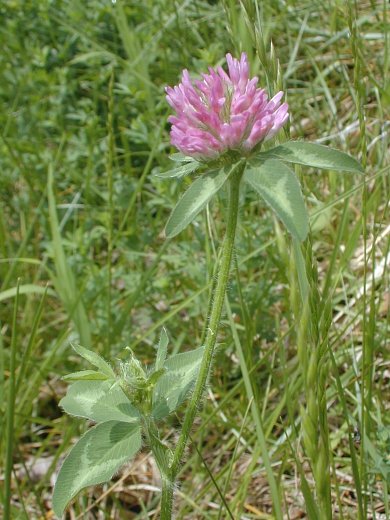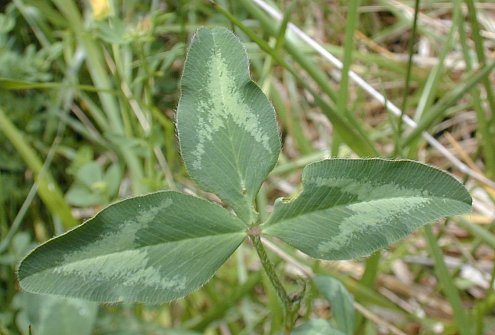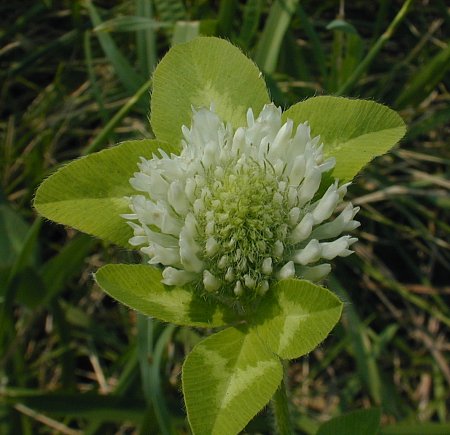Description: This herbaceous perennial plant is ½–2' tall, branching occasionally. The hairy stems are sprawling or erect. The alternate compound leaves are trifoliate. The lower compound leaves have long hairy petioles, while the upper leaves have short petioles or they are sessile. The leaflets are up to 2" long and ¾" across. They are oval-ovate or slightly obovate; sometimes they are a little broader below the middle. Their margins are smooth and ciliate and their tips are blunt. Toward the middle of the upper surface of each leaflet, there is usually a chevron that is white or light green. The leaflets are sessile and lack petioles of their own. At the base of each compound leaf, there is a pair of ovate stipules up to ½" long. The upper stems terminate in flowerheads that are spheroid or ovoid. Usually there are 1-3 leaflets immediately beneath each flowerhead, as well as several green bracts with tips that abruptly taper to a slender tip. Each flowerhead is about 1" across and consists of numerous flowers. These flowers are sessile, tubular-shaped, and spread outward in different directions. Each flower has 5 narrow petals that are pink or purplish pink, becoming light pink or white toward the base of the flowerhead; a rare form of this species with white petals also exists. The upper petal is slightly longer than the lower petals. The light green calyx of each flower has 5 slender teeth and it is usually hairy.

The blooming
period usually occurs from late spring to mid-summer and lasts about
1-2 months. However, a few plants may bloom later in the summer or
fall. The flowers have a mild honey-like fragrance, while the foliage,
when it exists in abundance, produces a distinctive clover-like aroma
that is quite pleasant. Each flower is replaced by a small seedpod
containing 1 or 2 heart-shaped seeds. The root system consists of a
taproot and produces rhizomes. This plant can spread vegetatively or by
reseeding itself.
Cultivation:
The preference is full sun, mesic conditions, and a loam or clay-loam
soil. This plant adds nitrogen to the soil by forming root nodules that
accommodate rhizobial bacteria. Partial sun is tolerated.
Range & Habitat:
The non-native Red Clover is a common plant that occurs in every county
of Illinois (see Distribution
Map). It was introduced from Eurasia as a
fodder crop for farm animals and as a cover crop to improve
agricultural soil. Habitats include fields, pastures, weedy meadows,
vacant lots, grassy areas along roads, waste areas, and
degraded prairie remnants. This plant occurs in native
habitats occasionally, but it is only slightly to moderately
aggressive. It is often found in grassy areas that are not subjected to
regular mowing.

Faunal Associations: The nectar and pollen of the flowers attract many kinds of long-tongued bees, including bumblebees, Anthophorine bees, mason bees, and large leaf-cutting bees (Megachilini tribe). Butterflies, skippers, and day-flying Sphinx moths also visit the flowers for nectar. Typical visitors among the butterflies include Swallowtails, Monarchs, Painted Ladies, Whites, and Sulfurs. The caterpillars of several butterflies feed on the foliage of clovers (Trifolium spp.), including Everes comyntas (Eastern Tailed-Blue), Colias eurytheme (Orange Sulfur), Colias philodice (Clouded Sulfur), and Colias cesonia (Dog-Faced Sulfur). In addition, other insects feed on foliage, seeds, plant juices, and other parts of Red Clover (Trifolium pratense) and other clovers. This includes Cerotoma trifurcata (Bean Leaf Beetle) and other leaf beetles, Tychius stephensi (Red Clover Seed Weevil) and other weevils, larvae of Dasineura leguminicola (Clover Seed Midge), Alydus conspersus (Broad-headed Bug sp.), Euschistus variolarius (One-spotted Stink Bug) and other stink bugs, Nearctaphis crataegifoliae (Long-beaked Clover Aphid) and other aphids, Tortistilus inermis (Treehopper sp.) and other treehoppers, Pseudococcus dolichomelos (False Trochanter Mealybug), larvae of Aristotelia roseosuffusella (Clover Aristotelia Moth) and other moths, and Melanoplus borealis (Northern Grasshopper) and other grasshoppers. The Insect Table has a more complete listing of these species. The foliage, and to a lesser extent the flowerheads and seeds, of clovers are eaten occasionally by the Canada Goose and such upland gamebirds as the Ruffed Grouse, Greater Prairie Chicken, Wild Turkey, and Hungarian Partridge. Some granivorous songbirds, including the Horned Lark, Chipping Sparrow, and Mourning Dove, also eat the seeds (Martin et al., 1951/1961; DeVore et al., 2004; Bellrose, 1942/1976; Bennetts, 1900). Many herbivorous mammals also feed on the foliage, flowerheads, or seeds of clovers. This include smaller mammals, such as the Prairie Vole, Meadow Vole, Woodland Vole, Thirteen-lined Ground Squirrel, Groundhog, Cottontail Rabbit, Groundhog, and Plains Pocket Gopher, and larger animals, such as the American Black Bear, White-tailed Deer, Elk, horses, cattle, goats, and sheep (Martin et al., 1951/1961; Schneider et al., 2006; Lindroth & Batzli, 1984; Romain et al., 2013). There is some evidence that White-tailed Deer can spread viable seeds of Red Clover to new locations through their droppings (Myers et al., 2004). The value of Red Clover to wildlife and domestic farm animals is high.

Photographic
Location:
A weedy meadow at Judge Webber Park in Urbana, Illinois.
Comments:
Among the various Trifolium spp. (Clovers), Red
Clover is fairly easy to identify because of its large pink flowerheads
and the white chevrons on its leaflets. It is unusual among the clovers
in having sessile leaflets at the base of the flowerheads. There is
some variability in the hairiness of the foliage and the color of the
flowers. The common name is somewhat misleading because the flowers are
never a true red. On rare occasions, a compound leaf will produce 4 or
more leaflets.